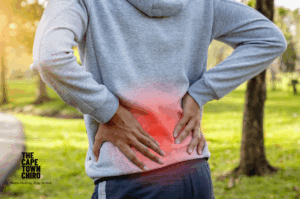Pain When Bending Forward or Tying Your Shoes? It Might Be This…
Ever bent down to tie your shoes and felt a sudden sharp pain in your lower back or buttock? Or maybe you notice an ache when leaning forward to pick something up. While most people blame a “slipped disc” or “tight hamstrings,” there’s another common culprit that’s often overlooked: sacroiliac joint (SIJ) syndrome.
What is the Sacroiliac Joint (SIJ)?
The sacroiliac joints are where your spine connects to your pelvis — two small but crucial joints that absorb shock between your upper body and legs.
If these joints become irritated, inflamed, or restricted, they can trigger sharp or deep aching pain in the lower back, buttocks, and even down the leg.
Why It Hurts When Bending Forward
When you bend forward (like tying your shoes):
-
Your pelvis tilts
-
The SI joints are loaded
-
If irritated, they can send pain signals as they’re compressed or stretched
People often describe this pain as:
-
Sharp, stabbing, or catching pain near the dimples of the lower back
-
One-sided (but sometimes both)
-
Worse after sitting for long periods
-
Sometimes radiating into the buttock or hamstring region
How SIJ Syndrome Is Diagnosed
At Chiropractor Cape Town | Dr Tristan Koekemoer, we use a combination of:
-
Thorough case history
-
Orthopaedic and biomechanical tests
-
Neurological screening to rule out disc-related pain
-
SIJ provocation tests to confirm diagnosis
How to Treat It
Evidence-based care for SIJ syndrome includes:
-
Manual therapy to restore joint motion
-
Dry needling or IFC for pain relief
-
Strengthening the glutes, hamstrings, and core
-
Education on posture and lifting mechanics
-
Gradual return to sport or running
Most patients improve within 2–6 weeks with the right plan.
Get Assessed in Cape Town
Don’t ignore persistent pain when bending forward — it’s not “just tightness.”
Book your consult today and let’s get you moving pain-free.
🔗 Learn more about SIJ Syndrome
❓ FAQ
Q: What causes SIJ syndrome?
A: It can be triggered by trauma (like a fall), pregnancy, repetitive heavy lifting, or muscle imbalances around the hips and pelvis.
Q: Is SIJ pain the same as a slipped disc?
A: No — SIJ pain is usually one-sided and doesn’t cause numbness or tingling. Disc pain often travels down the leg with nerve symptoms.
Q: Can I still exercise with SIJ pain?
A: Yes, but modify activities. Low-impact movements like walking, swimming, and targeted core/glute strengthening are encouraged.
Q: How long does SIJ pain take to heal?
A: With the right care, many people see improvement in 2–6 weeks.
Related Articles
Lower Back Pain After Deadlifts? Here’s What’s Actually Going On
Mechanical Lower Back Pain: What It Is, Why It Happens, and How You Actually Get Better
Herniated Disc Worries? Here’s What Cape Town Chiropractors Want You to Know